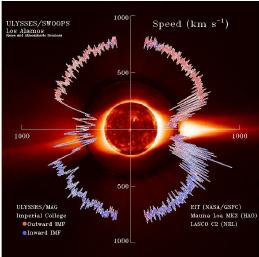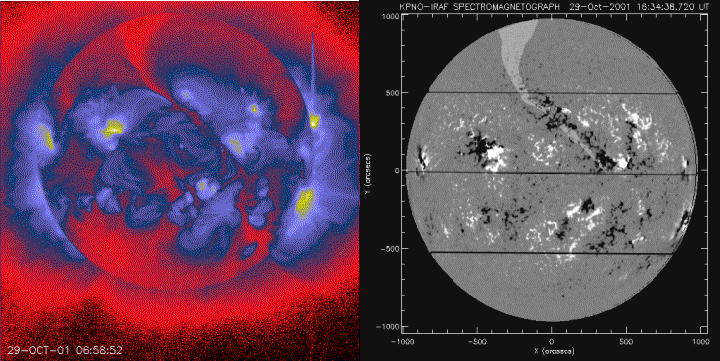
Slow solar wind coming from active regions
The image within the graph above (not from Yohkoh although it could have been!) illustrates schematically what the story is. At high latitudes one has the "polar coronal holes", and at low latitudes the "streamer belt," near which the sunspots (active regions) reside. At minimum activity this results in the clear pattern shown; when the Sun is near its sunspot maxima the picture gets much more confused. The basic reason for this, apparently, is that active-region magnetism literally punches holes in the corona, allowing it to flow outward as a solar wind of much greater complexity. For reasons we don't understand yet, this active-region flow is slower, not faster as one might anticipate somehow.
The thing we have found is the "narrow coronal hole", a thin cleft of magnetic field that frequently forms as an extension of a larger hole. The example below, from our previous nugget, shows how this works:

The skinny coronal hole ("narrow coronal hole" for dignity, or "cowlick" according to Paulett Liewer of JPL) is the diagonal feature. Its outline overlaid on the magnetogram (right panel) shows that it contains considerable negative magnetic flux (black means pointing into the Sun). It closely approaches an active region, but interestingly enough neither this example nor any of the others reported at Solar Wind 10 actually included sunspots. Since these contain the strongest fields, one might well be mystified by this property - we don't have any ready explanation.
To locate the solar source of something in the solar wind, one needs to trace its flow back to the point of origin. This is harder than it sounds, because we only have extremely limited views of the solar wind itself - we know it precisely at a very few individual points, such as the location of Ulysses or one of several other spacecraft in deep space. We also know it from "interplanetary scintillation," not yet described in these science nuggets. A standard method to link a point in the wind with something on the solar surface is to make a two-part extrapolation (ballistic wind plus simple potential-field mapping of the corona). We won't go into the details of this process, but show instead its results for two examples:
Don't expect to follow all of this complexity immediately; just trust us that we've identified narrow coronal holes with sources of the slow solar wind, and perhaps check out a copy of the Solar Wind 10 proceedings when it comes out later in 2002.
We will promise to re-visit this subject (how to make the connections) again in a future nugget.
What's presented here is probably Yohkoh's most innovative contribution to solar-wind research yet. The fact that solar wind can emerge from within sunspot regions (but probably not from spots themselves) promises to teach us a great deal about how the coronal field works and how the Sun organizes its most important non-radiative link to the Universe, i.e. its perpetually expanding outer atmosphere.
June 21, 2002
Hugh Hudson (hudson@lmsal.com)